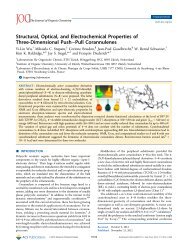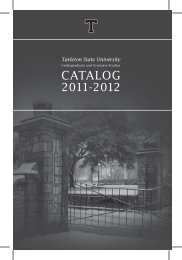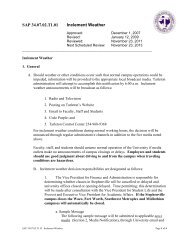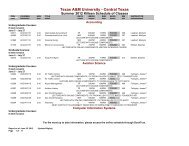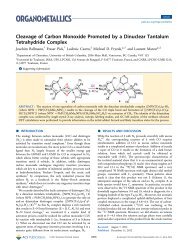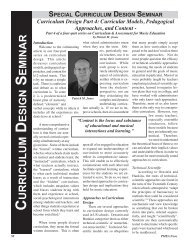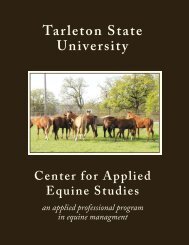Dr. David Kattes, professor of Environmental and Agricultural ...
Dr. David Kattes, professor of Environmental and Agricultural ...
Dr. David Kattes, professor of Environmental and Agricultural ...
You also want an ePaper? Increase the reach of your titles
YUMPU automatically turns print PDFs into web optimized ePapers that Google loves.
<strong>Dr</strong>. <strong>David</strong> <strong>Kattes</strong>, <strong>pr<strong>of</strong>essor</strong> <strong>of</strong> Agribusiness, Agronomy, Horticulture <strong>and</strong> Range Management, is the 2010<br />
recipient <strong>of</strong> Tarleton’s Faculty Excellence in Scholarship Award for his research in the fields <strong>of</strong> tick <strong>and</strong><br />
filth fly management, parasitoids <strong>of</strong> black widow spiders, establishment <strong>of</strong> native grasses <strong>and</strong><br />
management <strong>of</strong> Bermuda grass.<br />
<strong>Kattes</strong> shares the credit for his accomplishments with all the faculty members <strong>and</strong> researchers who<br />
collaborate with him <strong>and</strong> with the undergraduate <strong>and</strong> graduate student researchers he recruits <strong>and</strong><br />
mentors. He also notes how much he values events like the Tarleton Research Symposium <strong>and</strong> the<br />
Texas A&M University System’s Pathways Research Symposium, which give his students valuable public<br />
speaking experience <strong>and</strong> also have helped him meet <strong>and</strong> establish research partnerships with faculty<br />
from other universities.<br />
COLLABORATIVE RESEARCH<br />
As one example <strong>of</strong> collaborative research, he describes an on-going project to determine whether <strong>and</strong><br />
how naturally occurring plant compounds, such as condensed tannins, might be used as another<br />
tool to manage filth flies in confined animal operations. Tannins are bitter plant chemicals that affect<br />
protein absorption in many animals. Some animals, such as deer <strong>and</strong> goats, can consume the materials<br />
with no ill affect. Previous research has suggested these compounds can reduce the number <strong>of</strong> internal<br />
parasites in goats <strong>and</strong> may interfere with house fly development. In addition to <strong>Dr</strong>. <strong>Kattes</strong>, the project<br />
team includes:<br />
<strong>Dr</strong>. Barry Lambert, an animal nutritionist with a joint faculty appointment at Tarleton <strong>and</strong> the Agri-<br />
LIFE Research Center in Stephenville. <strong>Dr</strong>. Lambert is studying the metabolism <strong>and</strong> degradation<br />
<strong>of</strong> tannins fed to livestock.<br />
<strong>Dr</strong>. James Muir, a crop ecologist at the Agri-LIFE Research Center, is studying tannins present in<br />
various plants, particularly legumes.<br />
<strong>Dr</strong>. Jeff Tomberlin, an Extension entomologist, is studying the relationship <strong>of</strong> tannins to e coli<br />
bacteria in animal waste.<br />
<strong>Dr</strong>. Sonja Swiger, a Texas Extension veterinary entomologist, <strong>and</strong> <strong>Dr</strong>. Justin Tulley, an<br />
entomologist with the Oklahoma State Extension Service, are determining how to incorporate the<br />
team’s findings into actual practice.<br />
Tarleton undergraduate student Briana Jamison (supported with funding from a University<br />
Research Committee Organized Research Grant) is trying to define the preferred filth fly breeding<br />
environments in dairy operations.<br />
Tarleton graduate student Cassie Schoenthal is experimenting to determine the relationship<br />
between the amount <strong>of</strong> tannins, filth fly mortality rate <strong>and</strong> effects on E. coli residing in the manure.<br />
As a second example <strong>of</strong> cooperative research, <strong>Dr</strong>. <strong>Kattes</strong> describes a spinose ear tick study being<br />
conducted for the Fossil Rim Wildlife Center. In addition to <strong>Dr</strong>. <strong>Kattes</strong>, project team members include:<br />
<strong>Dr</strong>. Jeff Breeden, Tarleton wild-life management faculty<br />
Tarleton graduate student Christopher Niebuhr. Chris’ participation is supported by a Student<br />
Research Grant from the Office <strong>of</strong> Student Research <strong>and</strong> Creative Activities. He is supervising all<br />
field <strong>and</strong> lab activities <strong>and</strong> plans to work toward his Ph.D. in public health. <strong>Dr</strong>. Breeden is his<br />
faculty mentor.<br />
Tarleton undergraduate student Sarah Mays. Sarah, a Wildlife Science major, is surveying small<br />
mammals at the Center <strong>and</strong> identifying the tick species associated with each mammal species.<br />
A spinose ear tick (Otobius megnini) is a pink or blue-gray, leathery s<strong>of</strong>t tick whose larval <strong>and</strong> nymphal<br />
stages infest the ears <strong>of</strong> many animals. The Fossil Rim Wildlife Center is home to 1,100 animals<br />
representing 60 species, including antelope, bison, cheetahs <strong>and</strong> wolves. The 1,500 acre preserve<br />
includes numerous shelters <strong>and</strong> barns. Because wild animals can’t be treated routinely for ticks like<br />
domestic cattle <strong>and</strong> horses, the research project must determine where the ticks are in the preserve <strong>and</strong><br />
the most effective way(s) <strong>of</strong> eliminating them. Typically, adult ticks lay eggs in sheltered spots like cracks<br />
in poles, crevices <strong>and</strong> walls, under mangers, <strong>and</strong> under tree bark. Because the females need shelter,<br />
spinose ear ticks are typically found only on stabled animals that are close to breeding locations.
So far, the team has discovered ticks are most common in barns in cracks <strong>and</strong> crevices <strong>and</strong> in bedding<br />
materials no further than two feet from the walls. They also have removed a lot <strong>of</strong> tree bark but not found<br />
any ticks. In the fall 2010, they will be experimenting in the lab with various chemical solutions to<br />
determine which one(s) will drive ticks out from under bark <strong>and</strong> out <strong>of</strong> cracks. During the spring <strong>and</strong><br />
summer <strong>of</strong> 2011, the team will experiment with various control measures <strong>and</strong> assess their results.<br />
STUDENT RESEARCH<br />
While research obviously engages <strong>Dr</strong>. <strong>Kattes</strong>’ endless curiosity <strong>and</strong> wide-ranging intelligence, his<br />
students own his heart. Four years ago, <strong>Kattes</strong>’ met two young ladies in his Introduction to Crop<br />
Production class <strong>and</strong> developed an undergraduate research project based on their interests. He talks<br />
about Melody Minkley, who sat at his desk <strong>and</strong> said she wanted to get a degree in Range Management<br />
<strong>and</strong> then go back to her small Panh<strong>and</strong>le Texas hometown to help her father on the family ranch while<br />
working for the Soil Conservation Service. She’s now engaged to be married <strong>and</strong> a graduate student in<br />
the Range Management Department at Texas A&M University. Rebecca Hackey from deep East Texas,<br />
was raised on a chicken <strong>and</strong> cattle farm. Now she’s doing graduate work with <strong>Dr</strong>. Roger Wittie, Tarleton<br />
Pr<strong>of</strong>essor <strong>of</strong> Range Management, <strong>and</strong> <strong>Dr</strong>. Charles Hart, Pr<strong>of</strong>essor <strong>and</strong> Extension Range Specialist in the<br />
Department <strong>of</strong> Ecosystem Science <strong>and</strong> Management at Texas A&M University. “It’s a great feeling to see<br />
young folks mature pr<strong>of</strong>essionally <strong>and</strong> become your peers,” <strong>Kattes</strong> says.<br />
Then he leans back <strong>and</strong> reminisces about the best part <strong>of</strong> working with students: the moment when the<br />
light goes on. His home in De Leon (southwest <strong>of</strong> Stephenville) provides ample inspiration for field<br />
studies. He has four hay rings in three fields. A “hay ring” is the area occupied by a large, round bale <strong>of</strong><br />
hay used to feed livestock. When the round bale rings are removed, the vegetation that was under the<br />
bale usually is stunted or dead. Graduate student Michael Donaldson just joined <strong>Kattes</strong>’ research project<br />
to study Bermudagrass recovery under hay rings. Other faculty members involved in the study are <strong>Dr</strong>.<br />
R<strong>and</strong>y Harp (animal production), <strong>Dr</strong>. Barry Lambert (animal nutrition) <strong>and</strong> <strong>Dr</strong>. Donald McGahan<br />
(environmental soil scientist). While showing the student four hay rings in his three pastures, <strong>Kattes</strong><br />
started talking about replication <strong>and</strong> r<strong>and</strong>omization in research. When the student questioned replication,<br />
<strong>Kattes</strong> drove from a dry hay ring to one on wetter ground, stopped, <strong>and</strong> asked whether the student<br />
thought just experimenting with just the first ring would get the job done. The student turned to him <strong>and</strong><br />
said “well, I’ll be damned.”<br />
<strong>Kattes</strong> also serves as a resource person for Kimberly Thompson, who is doing her master’s thesis on the<br />
glassy-winged sharpshooter under the supervision <strong>of</strong> <strong>Dr</strong>. Forrest Mitchell, Pr<strong>of</strong>essor <strong>of</strong> Entomology at the<br />
Texas AgriLife Research Service. The sharpshooter invasive leafhopper insect is a vector for Pierce’s<br />
disease on grapevines. She is working closely with <strong>Dr</strong>. Roger Wittie, department head <strong>and</strong> <strong>pr<strong>of</strong>essor</strong> <strong>of</strong><br />
Agribusiness, Agronomy, Horticulture <strong>and</strong> Range Management. Team members also are studying what<br />
attracts green Junebugs so they can minimize the bugs’ destruction <strong>of</strong> grapes by attracting them away.<br />
RESEARCH SYMPOSIUMS<br />
<strong>Dr</strong>. <strong>Kattes</strong> observes that, from a global perspective, research problems now are so complex that any<br />
researcher working alone is unlikely to be able to produce useful results. At regional, teaching<br />
universities like Tarleton where time, facilities <strong>and</strong> funding are constrained, faculty benefit from the<br />
pr<strong>of</strong>essional interactions made possible by events that bring together faculty from other disciplines <strong>and</strong><br />
other universities. For example, at the 2009 Pathways Research Symposium, <strong>Kattes</strong> met <strong>Dr</strong>. <strong>David</strong> Beck,<br />
a microbiologist at Texas A&M-International (TAMUI) in Laredo, who shares his interest in ticks. These<br />
two scientists enlisted <strong>Dr</strong>. Fern<strong>and</strong>o Quintnana, a biostatician at TAMUI, <strong>and</strong> Ms. Man’Dee Mason, a<br />
Tarleton psychology instructor who is interested in how people underst<strong>and</strong> <strong>and</strong> deal with ticks. The four<br />
researchers are collaborating to determine the current knowledge <strong>of</strong> ticks, tick bites <strong>and</strong> tick transmitted<br />
diseases, by the general public <strong>and</strong> how to enhance their awareness <strong>of</strong> these serious pests.
If “scholarship” is defined as a “fund <strong>of</strong> learning <strong>and</strong> knowledge,” <strong>Dr</strong>. <strong>Kattes</strong> is evidence that scholarship is<br />
more than a list <strong>of</strong> publications. Scholarship is the process <strong>of</strong> actively learning with <strong>and</strong> from your<br />
colleagues <strong>and</strong> then constantly sharing your knowledge with others.



